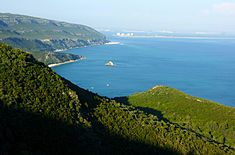Arrábida
| Nature Park of Arrábida (Parque Natural da Arrábida) | |
| Arrábida Nature Park | |
| Nature park (Parque Natural) | |
|
A scenic view of the coastal part of the Nature Park of Arrábida
|
|
| Official name: Parque Natural da Arrábida | |
| Named for: Serra da Arrábida | |
| Nickname: Arrábida/PNArr | |
| Country | |
|---|---|
| Region | Lisbon |
| Subregion | Península de Setúbal |
| District | Setúbal |
| Municipalities | Setúbal, Palmela |
| Cities | Setúbal, Palmela |
| Location | Parque Natural da Arrábida |
| - coordinates | 38°29′27.2″N 8°59′44.5″W / 38.490889°N 8.995694°WCoordinates: 38°29′27.2″N 8°59′44.5″W / 38.490889°N 8.995694°W |
| Highest point | Formosinho |
| - location | Serra da Arrábida, Setúbal |
| - elevation | 499 m (1,637 ft) |
| - coordinates | 38°28′51.57″N 9°0′1.05″W / 38.4809917°N 9.0002917°W |
| Lowest point | |
| - elevation | 0 m (0 ft) |
| - coordinates | 38°28′49.2″N 8°58′34.7″W / 38.480333°N 8.976306°W |
| Area | 72.2 km2 (28 sq mi) |
| Biomes | Atlantic, Mediterranean |
| Geology | Schist, Quartzites, Phyllite |
| Period | Jurassic, Miocene, Pliocene, Quaternary |
| Founded | 1940 |
| Date | 16 August 1971 |
| Management | Parque Natural da Arrábida Headquarters |
| Owner | Portuguese Republic |
| For public | Public |
| Easiest access | ' |
| Website: Parque Natural da Arrábida | |
The Nature Park of Arrábida (Portuguese: Parque Natural da Arrabida) is a protected area, founded in 1976 and covering an area of 108 square kilometres (42 sq mi), situated between the town of Sesimbra and the city of Setúbal, the hill of Palmela and the sea, including areas in the municipalities of Setúbal, Palmela, and Sesimbra in the Portuguese Península de Setúbal region, district of Setúbal.
The chain of elevations in the park—e.g., the hills of S. Luis, Gaiteiros, S. Francisco and Louro—reach their highest peak in Serra da Arrábida (499 metres (1,637 ft)), covered in Mediterranean-like vegetation and a microclimate of which resemble Adriatic locations such as Dalmatia, and chalky in constitution where the range comes into contact with the sea.
Three of the park's beaches—Galapinhos, Portinho da Arrábida and Figueirinha—are popular among the inhabitants of Lisbon and Setúbal. Overlooking the three beaches is the Convento de Nossa Senhora da Arrábida (Convent of Our Lady of Arrábida), a former monastery established in the 16th century, managed today by the Fundação Oriente.
The particular characteristics of the Arrábida massif, resulted (since the 1940s) in various attempts to protect the region, culminating in the creation of the Arrábida Reserve (Decree 355/71) on 16 August 1971, which covered the southern flanks of the mountains and cliffs of Risco. Recognizing the insufficient protection conferred on the area, Decree 622/76 was passed on 28 July 1976, creating the Parque Natural da Arrábida (PNArr). This classification envisioned the protection of the geological, forest, wildlife and landscapes, but also cultural and historical material located within the area.
...
Wikipedia

